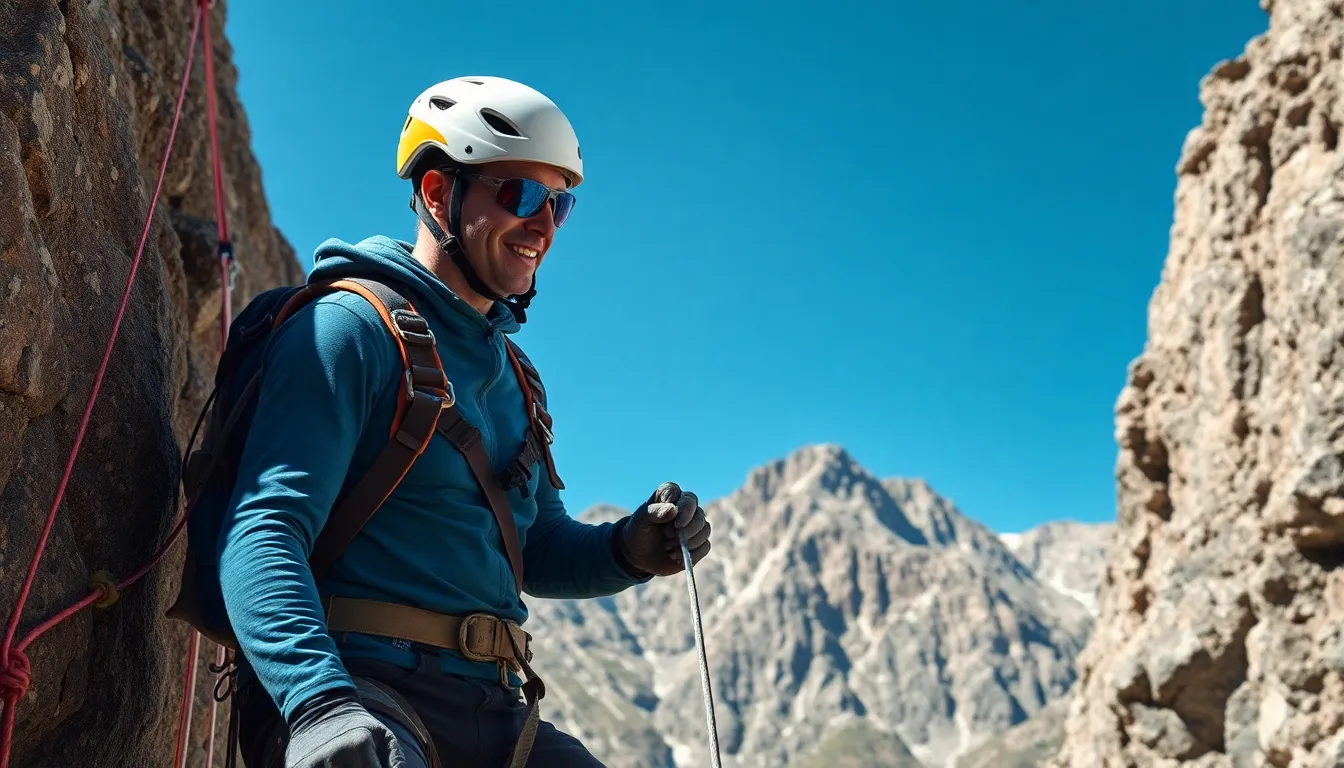Table of Contents
ToggleMountain climbing isn’t just a hobby; it’s an adventure that tests limits and pushes boundaries. But let’s face it: without the right gear, even the most daring climber might as well be attempting to scale a couch. From sturdy boots that grip like a toddler on a sugar rush to harnesses that keep you safer than a seatbelt in a minivan, the right equipment can make or break your ascent.
Overview of Mountain Climbing Gear
Mountain climbing gear encompasses various equipment designed to enhance safety and performance during climbs. Sturdy climbing boots provide essential support and grip on rugged terrain. Harnesses must fit securely, enabling freedom of movement while ensuring safety during ascents. Each piece of gear contributes to a climber’s overall experience and capabilities.
Protective equipment, such as helmets, serves to shield climbers from falling rocks and potential head injuries. Ropes, rated for climbing, carry critical importance, as they must withstand substantial weight and wear. Carabiners, often overlooked, play a vital role in connecting components, ensuring reliability in critical situations.
Climbing apparel, including moisture-wicking and insulating layers, guards against changing weather conditions. Many climbers opt for breathable fabrics that provide comfort during rigorous activity while retaining warmth in cooler climates. Gloves enhance grip and protection, crucial for maintaining control on challenging surfaces.
Additionally, some climbers invest in specialized gear, like ice axes and crampons, for mixed or icy conditions. Navigation tools, including maps and compasses, aid in route planning and orientation. First aid kits, while often forgotten, should remain on every climber’s checklist to address any injuries promptly.
Every aspect of mountain climbing gear contributes significantly to overall safety and success. Quality equipment not only enhances performance but also minimizes risks associated with the sport. Prioritizing the right gear leads to a more enjoyable and secure climbing experience.
Types of Mountain Climbing Gear

Mountain climbing gear categorizes into several essential types that ensure safety and performance.
Protective Equipment
Protective equipment plays a critical role in safeguarding climbers. Helmets protect against falls and falling debris, absorbing impacts effectively. Harnesses secure climbers to ropes and gear, allowing for freedom of movement without sacrificing safety. Additionally, gear like knee and elbow pads can reduce injury risk during falls or scrapes. Both chalk bags and gloves enhance grip on surfaces, supporting better handling of climbing holds. Eyewear protects against sun glare and flying debris, contributing to overall safety during the climb.
Technical Gear
Technical gear includes tools that facilitate challenging climbs. Ropes must have a rated strength, typically at least 7.8 mm for climbing, to support climbers safely. Carabiners made from lightweight materials connect various components, ensuring reliability in critical situations. Quickdraws assist in linking rope to anchors, enhancing efficiency while climbing. Devices like ascenders and descenders aid in navigating steep sections smoothly. Protection gear, such as cams and nuts, secures climbers to rocky surfaces, preventing falls and ensuring safety.
Clothing and Footwear
Clothing and footwear provide climbers with comfort and protection. Breathable, moisture-wicking base layers help regulate body temperature during climbs. Insulating mid-layers, such as fleece jackets, retain warmth against harsh weather conditions. Outer layers should be waterproof and windproof to shield against rain and wind. Sturdy climbing boots, often with a rubber sole, ensure adequate grip on various terrains. Crampons attach securely to boots for icy conditions, enhancing traction on slippery surfaces. Proper gloves maintain dexterity while providing necessary grip on equipment and holds.
Choosing the Right Gear
Selecting appropriate mountain climbing gear is critical for ensuring safety and performance. Several key factors influence the choice of equipment.
Factors to Consider
Experience level impacts gear selection. Beginners require more supportive and protective gear, while experienced climbers might opt for lighter options. The terrain plays a significant role as well. Rocky paths demand stable boots, while icy routes necessitate crampons and ice axes. Conditions like weather should influence choices, too. Moisture-wicking layers provide comfort during hikes, while waterproof jackets protect against rain. It’s vital to consider gear weight for carry efficiency. Lighter gear enhances mobility, especially on long climbs. Lastly, budget matters; investing in quality gear ensures safety without overspending.
Common Mistakes to Avoid
Avoid neglecting fit and comfort when selecting gear. Ill-fitting boots can cause blisters, while improperly fitting harnesses compromise safety. Choosing trendy gear over functional options can lead to poor performance. Focusing exclusively on price may result in choosing low-quality items that lack reliability. Skipping extensive research on gear types often causes climbers to unprepare for specific conditions. Ignoring maintenance routines for equipment can lead to failures when they are most needed. Lastly, don’t overlook essentials like first aid kits that prepare climbers for emergencies.
Maintenance and Care for Gear
Proper maintenance of mountain climbing gear ensures longevity and reliability. Cleaning climbing equipment after each use removes contaminants like dirt and moisture. Store gear in a cool, dry place to prevent damage from humidity and extreme temperatures.
Inspect all components regularly for signs of wear. Replace any equipment, such as ropes or harnesses, showing fraying or damage. Check gear before each climb; this prevents failures during critical moments.
Ropes require special care. Wash them with mild soap and water, avoiding harsh detergents that can weaken fibers. After cleaning, air dry ropes away from direct sunlight to maintain integrity.
Harnesses and helmets also demand attention. Wipe them down with a damp cloth to eliminate dirt. Inspect buckles and straps for functionality, ensuring a secure fit during climbs.
Carabiners benefit from periodic maintenance. Clean them using a brush to remove dirt and debris trapped in moving parts. Lubricate gates sparingly with appropriate oils to ensure smooth operation.
Other gear, such as climbing shoes and apparel, requires specific care. Wash shoes according to manufacturer guidelines to preserve grip and support. For clothing, follow care labels to maintain moisture-wicking and insulating properties.
For navigation tools, keep compasses and maps in protective cases. Avoid exposure to extreme weather that could compromise their effectiveness. Regularly update maps to ensure accuracy during climbs.
Following these maintenance tips safeguards gear. Taking these steps enhances performance and safety in mountain climbing adventures. Proper care ultimately contributes to a successful climbing experience.
Proper mountain climbing gear is vital for a safe and enjoyable experience. Each piece of equipment plays a significant role in ensuring climbers can tackle challenges effectively. From sturdy boots to reliable harnesses and protective gear, the right choices can mean the difference between a successful ascent and a dangerous situation.
Choosing gear that fits well and meets specific needs is crucial. Regular maintenance and care further enhance the longevity and reliability of equipment. By prioritizing quality and functionality over trends, climbers can focus on the adventure ahead with confidence. Investing in the right gear not only safeguards against potential hazards but also elevates the overall climbing experience.



